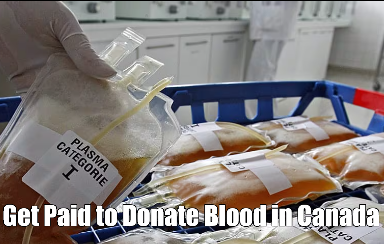
Donating blood is an important act of generosity and compassion as it saves lives, one person at a time. It is an act that can be useful to people who are in dire need of transfusions during surgeries, after an accident, or during some illness like leukemia. However, do you think it is possible for people to get paid for giving away blood in Canada? This is an issue that is contentious, and as such there are mixed feelings on the issue of compensation for donated blood. There are, however, viable ways wherein Canadians can receive money for donating their plasma. The purpose of this article is to provide insight into plasma donation in Canada while highlighting the process for donating plasma, the pros and cons, and additional facts to note if you wish to donate plasma.
Why Blood Donation Matters
Blood is life and healthcare revolves around it. It is always in demand, whether it is in a case of emergency or when patients are undergoing very delicate and complex surgeries which require a large intake of blood and blood products. All does the blood contain cells, platelets or plasma every part of it has its sole significant role in the body. Plasma for instance, which is the yellow colored fluid portion of blood is a vital ingredient in the creation of therapies used by persons with weakened immune systems or with hemophilia among other conditions.
To satiate that need however, Canada has implemented a blood donation program which they stand by firmly, but the question is how they treat those donations is the bigger cause for concern because of how intricate and sensitive the topic is. In the case of the blood donation program should they only accept voluntary donations or allow for compensated donations?
How Blood Donation Works in Canada
The Canadian people have actively participated in blood donation for a long time – blood donations to Canada is a tradition. canadianbloodservices.ca meets and exceeds the expectations for a strong system that provides blood supply while ensuring it is always safe. Apart from the entirely voluntary structure of the organization, CBS operates on the ‘not-for-profit’ basis. Their main objectives revolve around gaining the people’s confidence, ensuring safety and protecting the ethics of blood donation.
Even in the absence of a replacement of /advancing incentive structures, her deficiencies were overcome in Canada by the application of altruism in a stricter sense. For what reason are these blood components neither available on the local nor on the international market? Because neither CBS nor Héma-Québec pays their donors for the regular donation of blood, as is the case in some countries or regions.
We therefore conclude by mentioning that there is one domain where Canadians can receive money for giving a donation – that is plasma.
Understanding Voluntary Versus Paid Blood Donation
Blood donations can generally fall into two categories—voluntary and paid. Voluntary systems rely on donors offering blood solely out of goodwill. These systems emphasize public safety and accessibility while reducing the risks of exploitation. Programs run by Canadian Blood Services and Héma-Québec reflect this approach, ensuring an efficient national supply of essentials like whole blood and platelets.
Compensated blood donation, on the other hand, introduces monetary incentives. While this practice is less common globally, paid plasma donation operates within Canada under specific circumstances. Plasma donation differs slightly from donating whole blood due to its high demand and the unique way it’s processed and used.
Why Plasma Donation is Different
Plasma is in immense demand in Canada and beyond, primarily because it forms the base of life-saving medications. Collecting enough plasma through voluntary systems alone has proven challenging. To address this shortfall, private plasma collection companies operate alongside public organizations, offering payment for plasma donations in select provinces.
How to Get Paid to Donate Plasma in Canada
If you’re looking to get paid to donate blood—or more accurately, plasma—Canada has opportunities. Several private companies like Canadian Plasma Resources (CPR) compensate donors for their time and commitment. Here’s a breakdown of the process and what you should know before getting started.
Who is Eligible?
Eligibility requirements for plasma donation vary slightly depending on where you donate, but typical conditions include:
- Being at least 17 or 18 years old, depending on the center.
- Weighing at least 50 kilograms (110 pounds).
- Passing a basic health screening and having no disqualifying medical conditions or infectious diseases.
- Meeting residency requirements.
When you register with a plasma donation center, you’ll typically undergo a health check and answer a detailed questionnaire to ensure your safety and that of the recipients.
The Donation Process
Donating plasma differs somewhat from donating whole blood. Here’s what you can expect during the process:
- Registration and Screening – Once you’ve signed up, you’ll go through a medical screening to assess your health. This screening is repeated before each donation to ensure consistency.
- Plasmapheresis Procedure – Plasma is collected through a process called plasmapheresis. During this process, a machine separates the plasma from your blood and returns the remaining components—like red blood cells—back to you.
- Time Commitment – Unlike regular blood donations, plasma donation takes a bit longer. A typical session lasts around 90 minutes, though some centers streamline the process.
Compensation varies but typically ranges between $30 and $60 per donation. Most centers allow you to donate up to twice a week, so it’s a convenient option for those looking to supplement their income or simply do some good.
Ethical Considerations of Paid Blood Donation
The idea of paying donors for their blood or plasma has sparked heated debates worldwide. Critics argue that compensating donors could jeopardize the safety and ethics of the donation system. For example, some worry that payment could encourage dishonest donors to hide medical conditions just to qualify.
On the flip side, advocates point out that without financial incentives, it’s challenging to meet the growing demand for plasma products. Paid plasma programs operate under stringent guidelines to ensure donations are safe and ethical.
Canada’s hybrid system—voluntary for whole blood and incentivized for plasma—aims to strike a balance between addressing demand and protecting public health. Transparency and well-regulated compensation models are key to achieving this goal.
Benefits of Paid Plasma Donation
Paid plasma donation offers numerous benefits, both for the donor and the healthcare system.
For Donors
- Extra Income – Earning $30–$60 per donation provides a financial boost, especially for college students, part-time workers, or anyone else looking to supplement their budget.
- Flexible Schedule – Plasma centers offer regular hours, allowing donors to fit their contributions into their routine.
- Health Monitoring – Before each donation, donors undergo screenings that can help identify potential health concerns.
For the Healthcare System
- Meeting Demand – Paid donations help ensure a steady supply of plasma for critical therapies.
- Life-Saving Medications – Plasma-derived treatments benefit thousands of Canadian patients with chronic illnesses.
Potential Drawbacks of Paid Plasma Donation
Of course, there are potential downsides to consider. Some donors experience fatigue or minor bruising after donating, though this is typically mild and temporary. On a broader scale, critics worry that an emphasis on paid plasma collection could divert resources from voluntary programs, potentially impacting public trust.
Your decision to participate should depend on your personal circumstances, comfort level, and understanding of the system.
Canadian Voices on Paid Plasma Donation
Hearing from those who’ve participated can provide helpful insights. Many donors describe feeling fulfilled, knowing their contributions make a direct impact. For example, some donors share how they’ve been able to balance earning a little extra cash while helping others at the same time.
One Calgary resident, Sarah, said, “I started donating plasma when I was in university. The money helped me cover groceries, and I loved knowing it was going to help someone with a serious medical condition.”
Others point out the sense of community they feel at plasma donation centers. Shared goals—both humanitarian and financial—create connections among donors and staff alike.
Weighing the Decision
If you’re considering donating plasma for compensation, take your time to research your options and understand your eligibility. Find a reputable collection center, and be sure to follow their instructions closely to ensure a smooth experience.
It’s also worth weighing the ethical considerations and understanding how your choice fits into the broader healthcare system. Whether you choose to donate voluntarily or participate in paid plasma programs, the ultimate goal is contributing to a healthier community.
Final Thoughts
Getting paid to donate blood—or more specifically, plasma—is an option for Canadians looking to make a difference while earning extra income. Although traditional blood donation remains voluntary in Canada, compensated plasma donation programs play a critical role in meeting medical demand.
Both systems rely on trust, transparency, and ethical practices to ensure public health and safety. By learning more about the process, you can make an informed decision about whether paid plasma donation is right for you.
Donating blood or plasma isn’t just about money—it’s about saving lives and supporting those in need. Whichever path you choose, your contribution matters.




